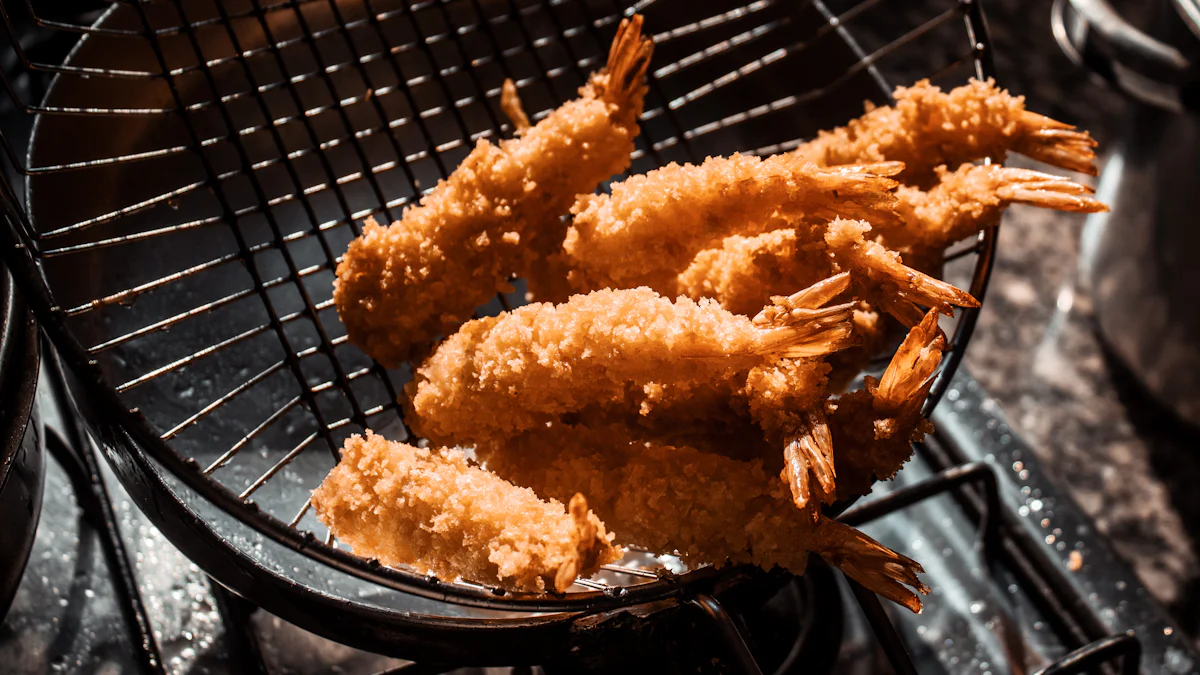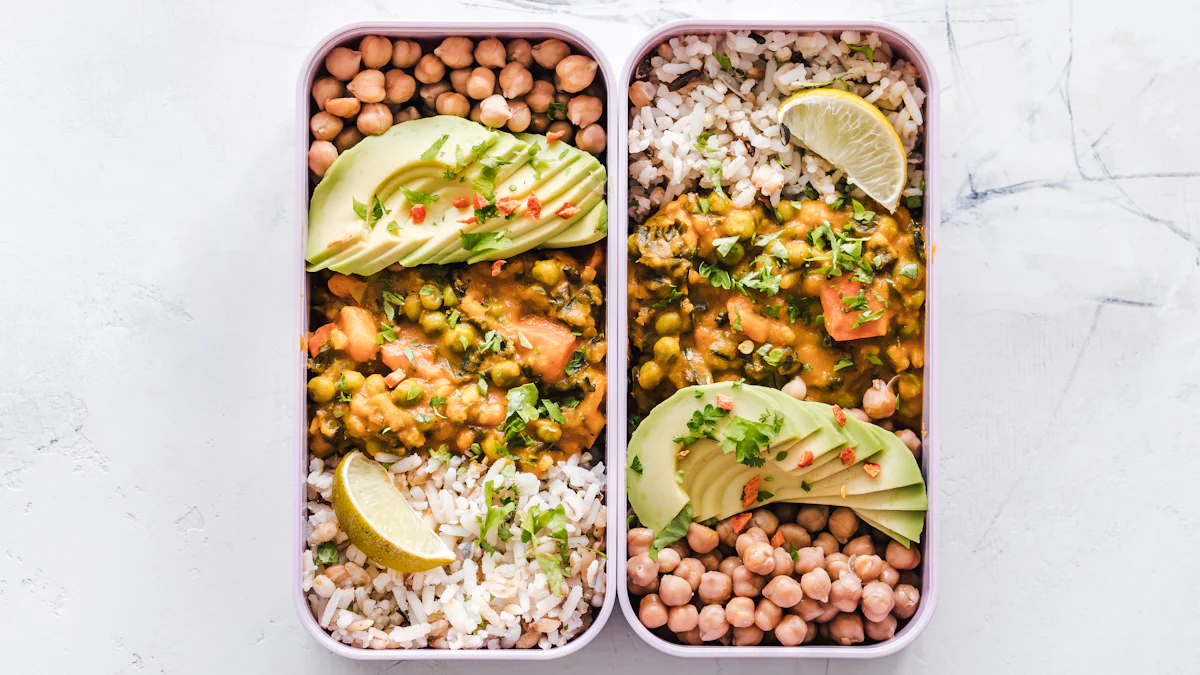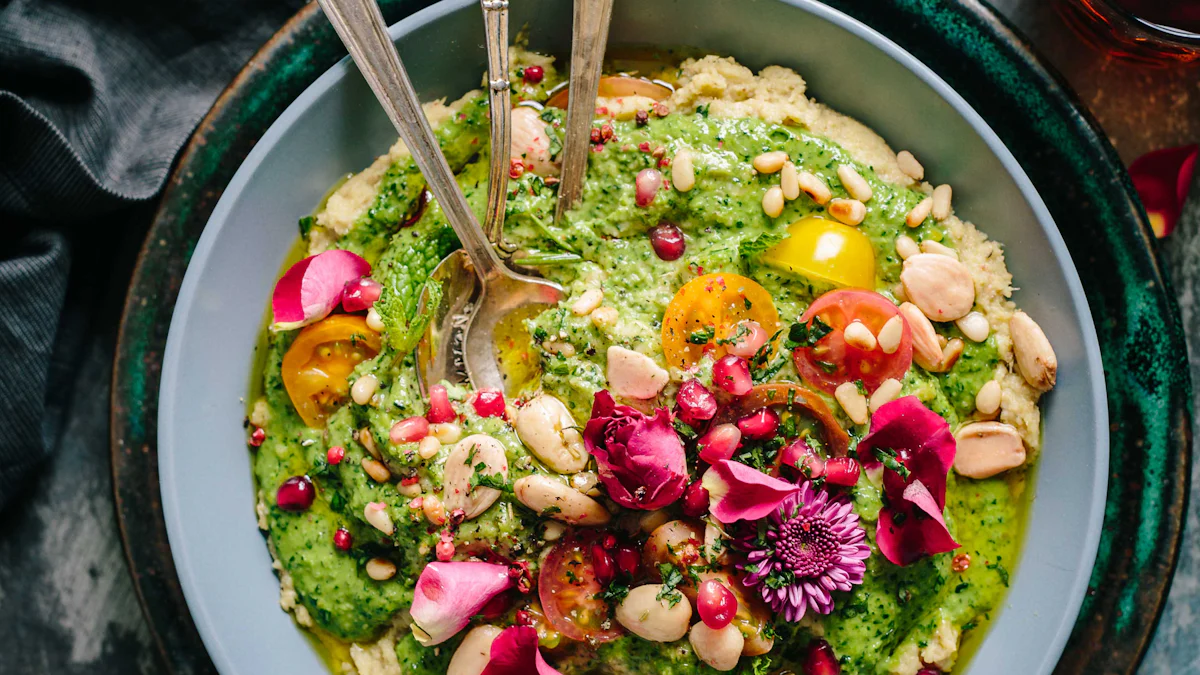
Cooking with an air fryer offers numerous health benefits. This innovative appliance uses significantly less oil compared to traditional frying methods, leading to up to a 90% reduction in oil left in food. The air fryer also creates fewer harmful compounds like acrylamide and advanced glycation end products (AGEs), making meals healthier. Additionally, air-fried foods contain 75% less fat and contribute fewer calories, reducing the risk of heart disease. The versatility and convenience of air fryers make them ideal for preparing a wide range of dishes quickly and efficiently.
Getting Started with Your Air Fryer
Understanding Your Air Fryer
Key Features to Look For
Selecting the right air fryer involves understanding its key features. Look for an adjustable temperature control to cook various dishes. A timer function ensures precise cooking times. Non-stick baskets simplify cleaning and maintenance. Consider the capacity based on your household size. Larger families benefit from a bigger basket, while smaller units suit single users or couples. Digital displays offer ease of use and accuracy. Some models include pre-set cooking programmes for different foods.
Basic Operation and Safety Tips
Operating an air fryer safely begins with reading the instruction manual. Always place the appliance on a flat, heat-resistant surface. Preheat the air fryer before adding food to ensure even cooking. Avoid overcrowding the basket to allow proper air circulation. Use tongs or a spatula to flip food halfway through the cooking process. This ensures even browning. Add a small amount of water to the drawer when cooking fatty foods. This prevents smoking and maintains the appliance’s condition. Always unplug the air fryer after use and let it cool before cleaning.
Initial Setup and Maintenance
Cleaning and Prepping Your Air Fryer
Proper cleaning and prepping extend the life of your air fryer. Start by removing all packaging materials. Wash the basket and pan with warm, soapy water. Dry thoroughly before reassembling. Wipe the exterior with a damp cloth. Avoid using abrasive cleaners or metal utensils that can damage the non-stick coating. Regular cleaning prevents the build-up of food residue and ensures optimal performance.
Regular Maintenance Tips
Regular maintenance keeps your air fryer in top condition. Inspect the power cord for any signs of wear or damage. Clean the heating element periodically to remove any grease or food particles. Check the fan blades for obstructions. Ensure the temperature controller functions correctly by testing it occasionally. Store the air fryer in a cool, dry place when not in use. Following these tips will help you enjoy healthy, delicious meals for years to come.
Healthy Cooking Techniques

Choosing the Right Ingredients
Opting for Fresh and Organic Produce
Selecting fresh and organic produce enhances the nutritional value of meals. Fresh vegetables and fruits contain higher levels of vitamins and minerals. Organic produce reduces exposure to pesticides and chemicals. Local farmers’ markets often provide a variety of fresh, organic options. Incorporating seasonal produce ensures peak flavour and nutrition.
Using Healthy Oils and Seasonings
Healthy oils and seasonings elevate the taste and health benefits of dishes. Extra virgin olive oil and avocado oil are excellent choices due to their high smoke points and beneficial fats. Avoid using oils with trans fats or hydrogenated oils. Herbs and spices like turmeric, garlic, and rosemary add flavour without extra calories. These seasonings also offer antioxidant properties, enhancing overall health.
Cooking Methods for Healthier Meals
Air Frying vs. Traditional Frying
Air frying offers a healthier alternative to traditional frying. This method uses hot air circulation to cook food, resulting in a crispy texture with minimal oil. Traditional frying submerges food in oil, increasing fat and calorie content. Studies indicate that air frying reduces acrylamide formation by up to 90%, lowering the risk of cancer. Air-fried foods also contain fewer advanced glycation end products (AGEs), which contribute to inflammation and chronic diseases.
Techniques for Reducing Fat and Calories
Several techniques can help reduce fat and calories when using an air fryer. Preheating the air fryer ensures even cooking, which helps achieve a crispy texture without excessive oil. Flipping food halfway through the cooking process promotes uniform browning. Adding a small amount of water to the drawer when cooking fatty foods prevents smoking and maintains the appliance’s condition. Using a cooking spray instead of pouring oil minimises fat intake. Batch cooking allows for meal prep, ensuring healthy options are always available.
Recipe Ideas for Healthy Meals

Breakfast Options
Healthy Air-Fried Omelettes
Air-fried omelettes offer a nutritious start to the day. Use fresh vegetables like spinach, tomatoes, and bell peppers. Add lean proteins such as turkey or chicken breast. Whisk eggs with a splash of milk for a fluffy texture. Pour the mixture into a greased air fryer-safe dish. Cook at 180°C for 10-12 minutes. Check for doneness by inserting a toothpick. Serve with a side of whole-grain toast.
Air-Fried Veggie Hash Browns
Veggie hash browns provide a healthy alternative to traditional versions. Grate potatoes, carrots, and zucchini. Squeeze out excess moisture using a clean kitchen towel. Mix the grated vegetables with a beaten egg and a pinch of salt. Form small patties and place them in the air fryer basket. Cook at 200°C for 15 minutes, flipping halfway through. Enjoy with a dollop of Greek yoghurt or a sprinkle of fresh herbs.
Lunch and Dinner Recipes
Air-Fried Chicken and Fish
Air-fried chicken and fish deliver crispy results without excess oil. Marinate chicken breasts or fish fillets in lemon juice, garlic, and herbs. Coat with whole-wheat breadcrumbs for added crunch. Preheat the air fryer to 190°C. Place the protein in the basket, ensuring even spacing. Cook chicken for 20-25 minutes and fish for 12-15 minutes. Check internal temperatures: 75°C for chicken and 63°C for fish. Serve with steamed vegetables or a fresh salad.
Vegetarian and Vegan Options
Vegetarian and vegan dishes shine in the air fryer. Prepare stuffed bell peppers with quinoa, black beans, and corn. Top with vegan cheese for extra flavour. Cook at 180°C for 15-20 minutes. Another option includes air-fried tofu. Press tofu to remove excess water. Cut into cubes and toss with soy sauce and sesame oil. Cook at 200°C for 10-12 minutes, shaking the basket halfway through. Pair with brown rice and stir-fried vegetables.
Snacks and Desserts
Air-Fried Veggie Chips
Veggie chips make a perfect snack. Slice sweet potatoes, beetroots, and courgettes thinly. Toss with a small amount of olive oil and sea salt. Arrange in a single layer in the air fryer basket. Cook at 180°C for 10-15 minutes, shaking occasionally. Allow chips to cool slightly before serving. These provide a crunchy, guilt-free snack option.
Low-Calorie Desserts
Low-calorie desserts satisfy sweet cravings. Try air-fried apple slices sprinkled with cinnamon. Core and slice apples into rings. Lightly coat with a mixture of cinnamon and a touch of honey. Cook at 160°C for 8-10 minutes. Another choice involves air-fried banana coins. Slice bananas and sprinkle with a bit of cocoa powder. Cook at 180°C for 5-7 minutes. Serve with a dollop of low-fat Greek yoghurt for a delightful treat.
Advanced Tips and Tricks
Maximising Flavour
Marinating and Seasoning Tips
Marinating foods before air frying enhances flavour. Use acidic ingredients like lemon juice or vinegar to tenderise meat. Combine these with herbs, spices, and a small amount of oil. Allow the food to marinate for at least 30 minutes. For stronger flavours, marinate overnight in the refrigerator.
Seasoning plays a crucial role in air frying. Apply dry rubs directly to the surface of the food. Mix spices such as paprika, garlic powder, and black pepper for a robust taste. Avoid adding salt until after cooking to prevent moisture loss.
Using Herbs and Spices
Herbs and spices elevate the taste of air-fried dishes. Fresh herbs like rosemary, thyme, and basil add aromatic notes. Chop these finely and sprinkle over the food before cooking. Dried herbs work well too. Use oregano, parsley, and dill for a burst of flavour.
Spices offer depth and complexity. Cumin, coriander, and turmeric provide warmth and earthiness. Experiment with spice blends like curry powder or Cajun seasoning. These combinations create unique and exciting flavours.
Efficient Cooking
Batch Cooking and Meal Prep
Batch cooking saves time and ensures healthy meals are always available. Prepare large quantities of food in advance. Divide these into individual portions. Store these in airtight containers in the refrigerator or freezer. Reheat using the air fryer for a quick meal.
Meal prep involves planning and preparing ingredients ahead of time. Chop vegetables, marinate proteins, and measure out seasonings. Keep these ready to go in the refrigerator. This reduces cooking time and makes the process more efficient.
Time-Saving Tips
Several strategies can save time when using an air fryer. Preheat the air fryer before adding food. This ensures even cooking from the start. Arrange food in a single layer in the basket. Overcrowding leads to uneven results.
Flip food halfway through the cooking process. This promotes uniform browning and crispiness. Use a cooking spray instead of brushing oil. This provides a thin, even coating without excess fat. Invest in a good thermometer to monitor cooking temperatures accurately.
Expert Testimony: “Want to get the best results from your air fryer? Learn how with our expert tips for cooking, cleaning and day-to-day care.”
Focus on frozen foods when first using an air fryer. Frozen chips, chicken, and vegetables require less preparation. This allows users to understand how the air fryer cooks. Experimenting with these items builds confidence and familiarity with the appliance.
Using an air fryer offers numerous health benefits. The appliance reduces oil usage, lowers fat content, and minimises harmful compounds in food. Air frying promotes healthier eating habits and enhances meal preparation efficiency.
Experimenting with an air fryer can lead to discovering new recipes and cooking techniques. Trying different ingredients and methods can make cooking more enjoyable and versatile.
Sharing personal tips and recipes can build a supportive community. Readers can inspire others by contributing their experiences and culinary creations. Engaging with fellow air fryer enthusiasts fosters a collaborative and enriching environment.
See Also
Ensuring Your Cosori Air Fryer Lasts with 10 Tips
Beginner’s Guide: Using a Digital Air Fryer Effectively
Beginner’s Guide: Mastering the Clicks Air Fryer
Post time: Jul-10-2024

